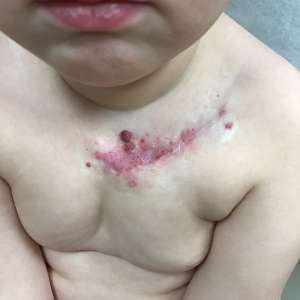Birthmark Surgery
 Over the years, Dr. Nicholas Bastidas has taken great pride in performing birthmark surgery for patients experiencing a broad range of conditions. As a Board certified plastic surgeon through the American Board of Plastic Surgery, Dr. Bastidas is qualified to perform the most complicated procedures with credentialed skills. Dr. Bastidas is part of a center of excellence, Center for Birthmarks, Cysts and Tumors, affiliating him with a specialized team performing in this arena of plastic surgery. Members of the team are available to each other for consultations and planning when a case involves a complexity of issues, providing the patient with an excellent team of resources to find a solution to meet their specific needs.
Over the years, Dr. Nicholas Bastidas has taken great pride in performing birthmark surgery for patients experiencing a broad range of conditions. As a Board certified plastic surgeon through the American Board of Plastic Surgery, Dr. Bastidas is qualified to perform the most complicated procedures with credentialed skills. Dr. Bastidas is part of a center of excellence, Center for Birthmarks, Cysts and Tumors, affiliating him with a specialized team performing in this arena of plastic surgery. Members of the team are available to each other for consultations and planning when a case involves a complexity of issues, providing the patient with an excellent team of resources to find a solution to meet their specific needs.
Several of the numerous birthmark surgery procedures performed by Dr. Bastidas include treatment for:
- Congenital Nevus – This is sometimes referred to as a mole or birthmark and is comprised of multiple pigmented cells located under the skin. A congenital nevus is a mole that is present at birth or noticed soon after. Initially they may appear pale, or slightly different in color. As the patient ages, they become brown and pigmented, sometimes containing hair.
- When very large (giant nevus) they can have higher rate of conversion to melanoma, making birthmark surgery for removal an important preventive procedure. When normal appearing birthmark or moles changing color or grow, this can be a sign of mutation or dysplasia.
- In children, a Spitz nevus, is a mole that shows signs of atypia (irregularity) that may be prone to become a skin cancer. A dermatologist should completely evaluate you or your child to determine if a mole is suspicious and would benefit from birthmark surgery excision.
- Sebaceous Nevus – Appearing as a smooth yellowish orange birthmark, often on the scalp or face. Birthmark surgery is frequently performed on a sebaceous nevus as it has a high risk of converting to basal cell carcinoma. Sebaceous nevus on the scalp, appears as a “bald spot” and will continue to grow in proportion to the child. Dr. Bastidas often removes these birthmarks in the office under local anesthesia, and prefers to perform scalp excisions at an early age due to the elasticity of the infant scalp.
- Hemangioma – A hemangioma is a benign vascular tumor that can appear almost anywhere on a body. As a stack of blood vessels, these sometimes continue to grow, requiring treatment or birthmark surgery depending upon the complications of this growth. A combination therapy of medical treatment, surgical excision and laser therapy may be required. We have a special team dedicated to hemangioma and vascular anomalies. For more info, please visit www.hemangioma.com
- Vascular Anomalies – These are abnormal growths of arteries, veins, lymphatic vessels and capillaries. A port wine stain is a capillary malformation, often on the face, that can be treated with laser therapy. Multiple sessions of pulsed dye light laser may be needed to reduce the port wine stain and restore normal skin color.
- Arterial Vascular Malformations (AVMs) are high flow vascular birthmarks. Many arterial malformations require birthmark surgery while others react to injections to clot off the feeding vessels (sclerotherapathy).
- Venous Vascular Malformations (VVMs) are a benign collection of veins underneath the skin. These can cause significant aesthetic and functional impairment depending on their location. A combination of surgery and sclerotherapy may be needed for treatment.
- Lymphatic malformations can often successfully be treated with sclerotherapathy, eliminating the need for birthmark surgery. However, a sub type (microcystic) often needs a combination of both medical and surgical therapy.
Birthmark surgery can most often be performed under local anesthesia, even for your children. Dr. Bastidas tried to limit the exposure of growing children to general anesthesia and has adapted safe methods of performing birthmark surgery under straight local, without need for sedatives or gases. All birthmarks removed are sent to the pathology laboratory for histologic examination and testing. Most results can be obtained within one week of the procedure.
Birthmark surgery and treatment for adults and children is some of the most rewarding work that Dr. Bastidas performs. He takes great comfort in treating these anomalies and reducing any risk they might subject to a patient. Dr. Bastidas prides himself on strong communication skills with his patients to assure that they fully understand this birthmark and its treatment. When you visit his websites at www.hemangioma.com, www.DrBastidas.com and www.ippcs.org you will recognize the commitment to high quality care and patient satisfaction. You deserve no less.